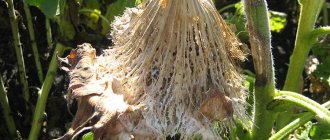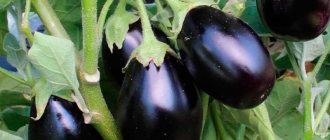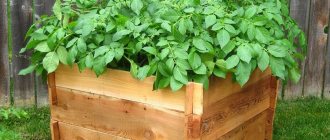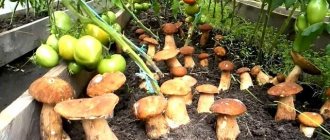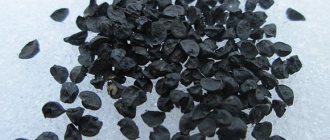Author: Natalya Category: Garden plants Published: April 04, 2017Republished: February 05, 2019Last edits: January 06, 2021
- When to plant sunflowers in the ground
- How to grow sunflowers
- Sunflower diseases
- When and how to harvest sunflowers
- Beneficial properties of sunflower
Sunflower (lat. Helianthus) is a genus of the Asteraceae family, numbering about fifty species that grow naturally in North and Central America and Peru. Sunflower cultivation was carried out by the Indians, who used the plant to relieve chest pain and treat fever, baked bread from it, and the pollen and petals of the plant in those days served as raw materials for purple-violet paint, which the natives used to make tattoos on their bodies. Sunflower oil was used to anoint hair, and altars and temples were decorated with inflorescences. Some species of the genus, representing oilseeds or ornamental plants, were exported to Spain in the 16th century, then they came to France and Italy, and by the end of the century they were already grown in Belgium, Switzerland, Germany, Holland and England. In Russia, sunflower became widespread after the Orthodox Church recognized it as a Lenten food product. Today, the sunflower plant is a valuable agricultural crop and is grown all over the world.
Planting and caring for sunflowers
- Planting: sowing seeds in open ground - at the end of April or at the beginning of May, when the soil at a depth of 10 cm warms up to 8-12 ˚C.
- Lighting: bright sunlight.
- Soil: any soil except acidic, swampy and saline, but fertile soils containing clay are more suitable.
- Watering: frequent and plentiful. Moisture is needed most before the plant forms 4 pairs of leaves, and then during budding, flowering and seed filling. In hot weather, watering should be daily, and in drought, the area should be watered 2-3 times a day.
- Fertilizing: regular throughout the growing season using both organic and mineral fertilizers. The method of introducing the main elements is root; the plant is supplied with microelements through foliar feeding.
- Reproduction: seed - seedlings and non-seedlings.
- Pests: steppe crickets, weevils, gnawing cutworms, sand sluggers, meadow moths, wireworms, May beetles and their larvae, herbivorous bugs, aphids.
- Diseases: downy mildew (downy mildew), embellisia (black spot), phomopsis (gray spot), stem blight, coal (ash) rot, dry rot, verticillium wilt, gray rot, alternaria (brown spot), sclerotinia (white rot) , ascochyta blight, powdery mildew, rust, broomrape, bacteriosis, viral mosaic and greening of flowers.
Read more about growing sunflowers below.
How to grow a sunflower seed
A mandatory procedure before growing sunflower seeds is their calibration (specimens must be full-sized, whole, not fried) and dressing. Seedlings are a favorite delicacy of birds and rodents. To scare away eaters, planting material must be treated with a special powder or solution before sowing. The dressing mixture can be purchased at a garden center or prepared at home. The solution, which is often used by summer residents, is made as follows:
- Peel the head of garlic and pass through a press.
- Combine the mixture with onion peels.
- Pour boiling water (2 liters) over the mixture.
- Leave for 24 hours.
- Strain.
For a positive effect, the seeds are kept in a garlic solution for 12 hours.
Some gardeners resort to seed germination before planting sunflowers. To do this, they are wrapped in a damp cloth, placed in a bag and put in a warm place for two days.
Sunflower plant - description
The oil sunflower (lat. Helianthus annuus) is an annual plant up to 2.5 m high with a taproot system penetrating to a depth of 2-3 m. The sunflower stem is erect, covered with hard hairs, non-branching, with an elastic and soft core. The leaves are alternate, long-petiolate, the upper ones sessile, and the lower ones opposite, oval-heart-shaped, with pointed tips. The length of the leaf plate with serrated edges, covered with hard hair, reaches 40 cm. The flowers are collected in very large baskets, surrounded by wrapping leaves. The buds and young baskets turn to follow the sun, changing orientation from east to west during the day, but as the plant matures, it fixes the position of the basket, although the leaves still turn to follow the sun. The marginal flowers of the baskets, from 4 to 7 cm long, are ligulate, sterile, and numerous internal ones are tubular, bisexual.
Typically, oil sunflower produces only one inflorescence, but sometimes additional shoots with small heads appear. Sunflower blooms for a month - from July to August, and is cross-pollinated with the help of wind and insects. The fruits are oblong, slightly compressed achenes with weakly defined edges, 8 to 15 mm long and 4 to 8 mm wide, with a leathery pericarp and gray, white, striped or black peel (husk). Inside the seeds are white kernels in the seed coat. Sunflower is an excellent honey plant.
How to plant a sunflower
Decorative sunflower - planting and care
The time when you need to start sowing sunflowers depends on the ambient temperature, soil, humidity, presence of weeds and other factors. It is recommended to start sowing 10-12 days after the start of field work.
Before you grow sunflowers in your country house or in production from seeds, you need to find out their quality, size, and examine them for physical damage.
Planting a sunflower
Care of young shoots is carried out mechanically. To achieve a good result, it is necessary to roll the soil with ring-spur rollers to preserve moisture. It should also be harrowed with additional processing using a cultivator with a weeding or sprinkling device.
Note! Chemical weeding can be done using herbicides. After 5 days have passed since sowing, it is necessary to harrow across the rows.
Growing sunflowers from seeds
Sowing sunflower seeds
It makes no sense to grow sunflower through seedlings, since its seedlings can tolerate light frosts. But if you still decide to grow sunflower seedlings, then sow the seeds 20-25 days before planting in the garden immediately in separate containers - in pots or, for example, in cut plastic bottles 28-30 cm high with drainage holes made in the bottom. Mix fertile soil with humus in equal proportions, fill the containers with the wet mixture, plant one or two seeds in each to a depth of 3-4 cm and be sure to press the soil so that it embraces the seeds on all sides. Place the crops in a warm place and cover them with film.
- Video of planting and caring for helenium
Growing sunflower seedlings
As soon as the seedlings appear, the crops are moved to a bright windowsill. Caring for seedlings consists of moistening the substrate, carefully loosening the soil and regular ventilation. A week before planting in open ground, seedlings are hardened by exposing them daily to the open air and gradually increasing the duration of the procedure.
Sunflower picking
The fact is that sunflower does not tolerate transplantation well, so it is better not to pick seedlings. Sunflower seedlings are planted in open ground in early June along with an earthen ball using the transshipment method. The sunflower planting scheme involves placing seedlings at a distance of a meter from each other. Be very careful not to damage the root system when replanting.
Sunflower harvest
The sunflower harvest begins in August. By this time, the heads bend toward the ground, the outer petals dry out and fall off, and the seeds turn black.
As the seeds ripen, they become heavier and the sunflower head droops.
Ripe caps are cut off and, if necessary, placed to dry (1-2 days). Remove the seeds over a spread cloth. The heads rub against each other until all the seeds fall out.
The seeds are dried in the shade, poured onto a substrate in one layer. After waiting for windy weather, the seeds are sifted. To do this, they are taken out into the open, collected in any container and poured back from a height of human height, thereby removing debris.
Sunflower head ripe for harvest
Store sunflower seeds in a dry place in hermetically sealed containers or in non-woven bags.
Sowing sunflowers in open ground
When to plant sunflowers in the ground
Sunflowers are sown at the end of April or at the beginning of May, when the soil warms up to 8-12 ºC. The crop is unpretentious to growing conditions - seedlings can withstand frosts down to -5 ºC and drought. However, there are a few caveats:
- do not grow sunflowers for several years in one place, take a break for 3-4 years;
- do not plant sunflowers where tomatoes, beets or legumes grew last season;
- the best predecessors for sunflower are corn and grains;
- When planting sunflowers, keep in mind that no crop can fully grow within the diameter of its root system.
Sunflower soil
Fertile soils with some clay in the roots and moisture under them will be optimal for sunflowers. In general, sunflower is able to adapt to any type of soil - both light and heavy. Acidic, swampy and saline soils are not at all suitable for the culture.
Before sowing sunflowers, you should prepare the area: clear it of weeds and apply complex mineral fertilizers for digging. Some gardeners do not consider it necessary to fertilize the soil specifically for this crop, believing that if other vegetables grow well on the site, then sunflowers will also grow.
How to plant sunflowers in open ground
Before sowing, sunflower seeds need to be calibrated, and then pickled for 14 hours in a one percent solution of potassium permanganate or kept overnight in a garlic-onion infusion, for the preparation of which 100 g of garlic are crushed, mixed with onion skins, poured with two liters of boiling water, infused for a day and filtered through gauze. Using garlic infusion to treat seeds will not only kill all pathogens, but will also repel pests and rodents from the seeds for the first time.
Sunflowers are sown in moist soil to a depth of about 8 cm, leaving 2-3 seeds in the nest. A distance of about a meter is maintained between large sunflowers, and about 60 cm between varieties of medium height. The greater the distance between plants, the larger the seeds of the new harvest will be.
What to plant after sunflower
Growing sunflowers greatly depletes the soil, so it makes no sense to plant vegetables after it; it is better to plant some kind of legume crop - soybeans, beans, peas, vetch, lupine. Legumes will allow the soil to rest and saturate it with nitrogen. The next year after legumes, cucumbers can be grown in this place.
Favorable and unfavorable sowing days
Depending on the growing region, sunflower sowing in open ground is carried out from March to June. Suitable timing for sowing sunflowers is determined taking into account climatic conditions and the position of the Moon, since the celestial body affects the growth of crops. All work related to sowing is recommended to be carried out when the Moon is in its waxing phase.
You should not organize planting on a new or full moon, as plant growth will be slow. Days when the celestial body is in a declining state are also identified as unfavorable periods for carrying out work.
Sticking to the deadlines indicated in the sowing calendar is not enough. When planting, it is necessary to take into account sowing norms, maintain the distance between rows, and properly treat the soil and seeds.
Sunflower care
How to grow sunflowers
If you want to get large seeds, you will have to take care of the sunflower. What does it mean? It is necessary to regularly water, remove weeds and loosen the soil around plants and between rows, apply fertilizing, and protect plants from diseases and pests.
Watering sunflowers
Water the sunflowers as needed. The plant especially needs moisture until 4 pairs of leaves are formed. The next stage of increased moisture demand occurs during the formation of inflorescences, and then during the period of flowering and seed filling. When moistening sunflowers, not only the frequency of watering is important - it is necessary to saturate the soil to the depth of the plant roots. In the summer heat, sunflowers are watered daily, but if drought occurs, you will have to moisten the soil two or even three times a day - sunflowers are very moisture-loving.
Sunflower feeding
Since sunflower needs a large amount of nutrients, after the formation of the third pair of leaves it should be fed: 20-40 g of superphosphate is added to each m² of plot, scattering dry fertilizer over the surface. Then the granules are embedded in the soil to a depth of 10 cm, after which the area is watered.
As soon as the baskets are formed, add potassium-nitrogen fertilizer to the soil: add a tablespoon of potassium sulfate to a bucket of mullein solution (1:10). Fertilize the plants again with the same solution during seed ripening.
Sometimes bubbly distortions appear on the sunflower leaves, cracks form on the stems, and it becomes brittle. These are signs of a lack of boron in the soil. In this case, you need to treat the plant leaves with a boron-containing preparation.
- Motherwort: cultivation, properties, types and varieties
How to properly plant a sunflower from a seed
Many lovers of growing ornamental plants plant sunflowers in their dachas. Growing a sunflower from a small seed is a very interesting process. The sunflower is growing by leaps and bounds. A small seed is planted in the ground, and soon from this seed grows a real decoration for any dacha - a bright yellow sunflower. Many novice gardeners mistakenly believe that growing sunflowers from seeds in the middle zone is quite difficult, because sunflowers grow well only in the south.
Such gardeners do not plant sunflowers on their plots, and it is completely in vain. These wonderful flowers, which delight the eye all summer, grow beautifully in central Russia. The main thing is to grow sunflowers from seeds correctly.
How to grow a sunflower from a seed
Before you start growing sunflowers from seeds, you need to properly prepare the planting material. You should not use roasted seeds for planting, which are sold on trays on the street or in packages in supermarkets.
Such seeds may contain various flavoring additives (salt, spices), and because of them the seed may simply not germinate. The ideal option is seeds from last year's sunflower, which was grown at home or in the country. You can also purchase seeds in specialized stores for gardeners, in the seed department. In this case, the main advantage is that you can choose one of several varieties of this wonderful flower: more frost-resistant, or, conversely, more heat-loving, more “capricious,” or, conversely, more unpretentious. You can also choose sunflower varieties with different shapes and shades of flowers. However, you should not rely on the picture on the packaging, because the result may differ greatly from the photograph. The main thing is to look at the expiration date of the seeds. This option is suitable for “advanced” gardeners who are well versed in different varieties of sunflowers.
And for those who are planting sunflowers on their plot or at home for the first time, we can advise you to simply purchase unroasted sunflower seeds at any grocery store and use them as planting material. Planting material must meet the following requirements:
- The seeds should be large;
- They should be completely covered with peel;
- The seeds should not show signs of rot or mold (greyish coating, characteristic unpleasant odor);
- You should not select seeds for planting if they were stored in places where mice or rats live (for example, in a basement, in a village barn).
Pests and diseases of sunflower
Sunflower diseases
If sunflower is not properly cared for and agricultural practices are not followed, it can be affected by many diseases.
Peronosporosis, or downy mildew, is a fungal disease caused by the Plasmopara fungus. A diseased plant appears underdeveloped, its stems become thin and brittle, and its leaves become small and chlorotic, with a white coating on the underside of the blade. But there is a form of the disease in which the stems shorten and thicken. In one season, sunflowers that have almost completed their development can be re-infected with peronosporosis. In this case, small, irregularly shaped oily spots appear on the leaves, a whitish coating forms on their undersides, and the stems become light green. Then the infection penetrates into the basket, which, due to the lesion, stops developing.
Embellisia, or black spot, is a harmful disease that affects not only sunflowers, but even very resistant weeds. Signs of the disease appear on plants at the stage of development of 5-6 leaves: dark necrotic spots 3-5 mm in size appear on the plates, which grow and merge, forming spots 4-5 cm in size, surrounded by a yellow border. Dark elongated spots of irregular shape appear on the petioles, numerous cracks appear at the point where the petiole is attached to the stem, and black necrosis forms on the stem around the petiole. On baskets affected by embellisia, dark brown spots can also be seen.
Phomopsis, or gray spot, is one of the most dangerous fungal diseases that affects all parts of the plant. Dark brown angular necrosis appears on the leaves, as if from a burn, and the leaves, along with the petioles, dry out and die. On the stems around the affected petioles, brown necrosis with a clear outline also forms, which after a while turns gray and becomes covered with pycnidia. The stems become brittle and break easily. The disease progresses with high humidity in warm weather.
Stem blight is caused by a fungus and appears on young plants at the development stage of 6-8 leaves. Brown spots with a bright yellow rim appear on the leaves, they increase in size, covering the entire leaf and even the petiole. Then the fungus infects the tissues of the stem, and if infection occurs during flowering, then brown spots of irregular shape soon form on the basket, the seeds develop poorly, turn out to be half-empty, and then also turn brown.
Charcoal, or ash rot, is a fungal disease that also affects beets, potatoes and corn. The infection gathers at the neck of the root and, as it develops, moves up the stem, blocking the flow of useful substances through it, causing the leaves and top to begin to wither, dry out, and the plant may die. The disease progresses in hot weather with prolonged absence of precipitation.
Dry rot is caused by a fungus and is common everywhere. On the front side of the basket, rotting dark brown spots are found, which gradually dry out and harden. With severe damage, cells with grains easily move away from the base in whole layers. The seeds look flat, underdeveloped, stuck together, and have a bitter taste. Most often, the disease develops during a prolonged drought and after the sunflower is damaged by hail.
Gray rot is also caused by a fungus that can persist for a long time in the soil, on seeds, plant roots and in post-harvest plant residues. The infection becomes active in humid weather as the temperature drops. Brown spots appear on young plants, soon becoming covered with a grayish coating. Dark streaks with the same bloom form on the stems. The fungus also affects ripening baskets, causing oily spots to appear on their back side, the tissue in these places softens, becomes covered with plaque, rots and dies. Under favorable conditions for the fungus, it can negatively affect sunflower yields.
Verticillium wilt can lead to gradual tissue withering and even plant death. The causative agent of the disease is a fungus that attacks the vascular system of sunflower. The first signs of the disease are noticeable already during flowering, then verticillium appears on the leaves, which lose turgor between the veins, after which they wrinkle and die, but may not fall off for a long time. The infection affects the vessels of the stem, deteriorating the quality of the generative organs - if you cut the stem of the affected plant, you can see the pulp that has turned brown. The fungus becomes active during prolonged drought and heat.
Alternaria blight, or brown spot, caused by a fungus, affects the stems, leaves and seeds of sunflowers. First, brown necrotic spots appear on the leaves, which enlarge and take on irregular shapes. Sometimes Alternaria blight appears only at the end of the growing season. The disease develops against a background of high humidity and air temperature.
Sclerotinia, or white rot, affects sunflowers throughout the growing season, but can manifest itself in different ways. This disease is characterized by rapid development. Shoots affected by white rot die immediately. In young plants with 5-6 leaves at an air temperature of 16-18 ºC against a background of high humidity, a white felt coating forms on the leaves. As the disease develops, diseased tissues die, stems break and plants die. Wet light brown spots appear on the back of the basket, and the fabric underneath becomes soft. Root damage to sunflower by white rot reduces the supply of nutrients to the leaves and stems, which speeds up the death of the plant.
Ascochyta blight can appear throughout the growing season, but the symptoms become more obvious in the second half of summer: very dark, almost black spots of round or irregular shape, 1-2 cm in diameter, appear on the leaves, stems and baskets, and over time appear in the center of the spots pycnidia. The infection is of fungal origin.
Powdery mildew is common in the southern regions. It appears as a white powdery coating on the surface of the leaves, which gradually darkens and turns into a dense brown film. With intensive development of the disease, plant productivity decreases and the oil content in seeds decreases.
Rust is a fungal disease common in all places where sunflowers are grown. In spring, convex orange formations in the form of pads appear on the underside and sometimes on the upper side of the leaves - pustules, when cracked, rusty powder, which is fungal spores, crumbles. Rust causes the death of leaves, and if the infection is severe, other organs also suffer. Affected plants experience loss of moisture, metabolic disorders and developmental delays.
- Cucumbers: why they turn yellow in the greenhouse and in the garden
Broomrape is a single-stemmed parasite with light purple flowers and box-shaped fruits. The broomrape sprout attaches to the sunflower root, penetrates it and lives at the expense of the plant, greatly reducing its yield.
Bacteriosis, as is clear from the name of the disease, is of a bacterial nature. Sunflower tissues affected by the disease rot and become slimy, wither and dry out.
Mosaic is caused by the tobacco curly streak virus and is manifested by a change in sunflower leaves - they become variegated, then become deformed and lag behind in growth and development.
Greening of flowers is manifested by chlorosis of leaves, dwarfism, the formation of thin secondary shoots and sterility of flowers that acquire a green color. The disease is caused by mycoplasma bodies carried by leafhoppers.
Sunflower pests
Not only diseases, but also pests can affect the sunflower harvest. For example:
- steppe crickets are adult insects that damage the plant during the period when the first leaves appear and destroy the growing point. Most pests concentrate on the edges of areas;
- gnawing armyworms – the danger is posed by the first generation of pests: caterpillars located in the soil gnaw the stem at the root collar;
- sand slowworms - these beetles gnaw through seedlings and eat them;
- weevils - the most dangerous species are the southern gray, gray and gray beet weevils, which eat cotyledon leaves, bite stems and harm sprouts that have not yet emerged from the ground;
- meadow moths are distinguished by their great gluttony and omnivory: the larvae can eat the entire leaf surface, leaving only large veins; they also destroy the epidermis in baskets and stems;
- Herbivorous bugs suck the juices from the plant. The most dangerous thing is pest damage to achenes, which leads to their death;
- aphids damage young leaves, causing the leaf to wrinkle, turn yellow and turn brown. Plants affected by aphids lag behind in development;
- wireworms—the larvae of click beetles—eat up sown seeds and sprouts, and gnaw seedlings underground. Wireworms are dangerous until the sunflower develops 2-3 pairs of leaves;
- May beetle - its larvae, while in the ground, damage sunflowers and other crops, feeding on plant roots at the first stage of their development.
Sunflower processing
In order to protect sunflower crops from diseases and pests, it is necessary:
- observe crop rotation;
- choose disease- and pest-resistant sunflower varieties for cultivation;
- Before sowing, it is necessary to treat sunflower seeds with fungicides and insecticides;
- observe the timing and sowing pattern;
- regularly destroy weeds on the site;
- carry out preventive treatment of plants with fungicides and insecticides;
- remove plant residues from the site after harvesting;
- carry out deep plowing or digging of the site in the fall.
If during the growing season signs of fungal diseases appear on plants, the infection should be destroyed with solutions of systemic fungicides, for example, Apron or Cruiser. Stop processing at least a month before harvest. Viral diseases are incurable, so specimens affected by mosaic should be immediately removed and burned.
Treating seeds before sowing with insecticides protects seedlings from pests for 5-7 weeks, but then preventive spraying of sunflowers with solutions of broad-spectrum insecticides and acaricides, such as Zalp, Akarin, Actellik or Agravertin, should be carried out from time to time. Particularly dangerous are sucking insects - aphids and bedbugs, since they not only damage plants and suck the juices out of them, but are also carriers of incurable viral diseases.
When sunflowers ripen: harvesting time
Sunflower will be ready for harvesting after the moisture content of the kernel and husk has been reduced to 8-10% and the oil level has accumulated in the seeds that corresponds to the varietal characteristics. The sunflower kernel should become hard. During this period, sunflower caps, stems and leaves change color and dry out. The sunflower basket can no longer turn towards the sun, but constantly faces the east.
In warm sunny weather, the baskets are kept on the stems until the required level of ripeness. If precipitation begins, the baskets are cut off and allowed to dry under canopies in the shade. Then the seeds are knocked out of the caps and stored, spread out on shelves in a layer of about 1 m. The harvesting period for early sunflower varieties begins at the end of August and ends with the harvest of late varieties at the end of September.
In large areas of sunflower planting, to speed up the harvest time, sunflower is treated with desiccants, chemicals intended for pre-harvest drying of sunflower. This technique allows you to start harvesting sunflowers a week earlier. Such methods are not used at home.
In conditions of large volumes of sunflower cultivation, farmers use a powerful fleet of vehicles, sometimes even aircraft. Modern herbicides, insecticides, fungicides - the entire arsenal of chemical protective drugs is used when working with sunflower. But at home, in your garden, you can do without all these formidable weapons and grow environmentally friendly seeds that both grandchildren and children will happily gnaw on.
Sunflower harvesting and storage
When and how to harvest sunflowers
Sunflowers are harvested during the period of their full maturity, when the leaves and heads dry out and turn brown - it is at this time that the process of oil accumulation in the seeds is completed, the seed kernels harden, the peel acquires a color characteristic of the variety, and the seeds split when squeezed from the sides by the teeth. When no more than 15% of sunflowers with yellow reed flowers remain on the site, you can begin harvesting.
But sometimes the ripening of seeds coincides with the beginning of the rainy season, and the baskets do not have time to dry out on the vine. Seeds with high humidity should not be stored for storage. In such cases, on the eve of the onset of rains, plants in dry weather are treated with desiccants, which ensure rapid ripening - the seeds in the baskets will ripen a week earlier. This measure increases sunflower yields, the seeds are of high quality, and their humidity does not exceed 9%.
Sunflower harvesting must be completed within six days, otherwise the seeds will begin to fall off. When harvesting, the heads are cut 2-3 cm lower along the stem, then the seeds are removed from them using friction and the debris is blown off.
You can, without cutting, tilt the heads over the bucket and knock out the seeds from the baskets, tapping them on the back with something heavy. Ripe seeds themselves slip out of the nests into the bucket.
The third harvesting method allows you to preserve the harvest without any loss: the baskets are cut from 10 cm of the stem when only 2/3 of the seeds are ripe. Place fabric or paper bags on the heads and hang them for 2-3 weeks from the ceiling in a well-ventilated area, after which the ripe and dry seeds are easily removed from the nests.
The remaining stems in the area must be pulled out and burned, and the area must be plowed or dug to the depth of a spade bayonet.
Methods for storing sunflowers
The keeping quality of sunflower seeds depends on the integrity of their shells - grains with damaged skins are not protected from infection and quickly deteriorate. Organic impurities also reduce the shelf life of seeds, since they have increased hygroscopicity compared to seeds.
For long-term storage, only seeds that have been cleared of debris and winnowed with a moisture content of no more than 7%, cooled to 10 ºC, can be stored. Dry the seeds in a dry room with good ventilation. If the humidity exceeds 12%, it is necessary to increase ventilation during drying.
Dry seeds can be stored for six months. Keep them in a clean, dry, unheated room in fabric bags suspended from the ceiling.
Sunflower pests and their control
Many pests love to eat oilseed sunflowers. The sunflower moth (lat. Homoeosoma nebulella) is most common. She lays eggs in the basket at the stage of its formation, and later the larvae hatch and gnaw out the seed kernels. Also common pests are: southern weevil, wireworm, sunflower longhorned beetle, and thorn beetle.
Moth larva on sunflower
The following will help reduce the likelihood of insect damage: treating seeds before planting, timely removal of weeds, and maintaining crop rotation. If pests are found, the plantings are treated with insecticides - Taran, Desiccant, Actellik.
Birds can cause great damage to crops. To scare them away, bright multi-colored ribbons are tied near the sunflower caps. They also use tinsel or old computer disks. Often, summer residents install a scarecrow on their property.
Protecting sunflowers from birds
Wrapping the heads with breathable fabric, such as gauze, will help protect the seeds from birds and pests. This should be done only after pollination and left in this form until the seeds are completely ripe.
Types and varieties of sunflower
For commercial purposes, sunflowers are classified by the color of their husks. For example, sunflower varieties with black husks are classified as oil varieties, since they contain up to 50% oil, while varieties with striped husks are used for food production, including confectionery. Oil varieties, in turn, depending on the quantity and quality of acids contained in the seeds, are divided into polyunsaturated, monounsaturated and medium oleic.
According to the length of the growing season, sunflower varieties and hybrids are divided into early-ripening, mid-early, mid-ripening and mid-late. We offer you an introduction to the best varieties of sunflower:
- Lux is a highly productive, large-fruited, early-ripening, disease, drought and weed-resistant confectionery variety. Plants of this variety reach a height of 185 cm, the diameter of their basket is 25-27 cm, large kernels do not fit tightly to the walls of the achenes;
- Nut is a high-yielding, early-ripening universal variety that is resistant to weather conditions, weeds and some diseases and pests. Plants up to 170 cm high have large oval-oblong black seeds with a skin with a longitudinal dark gray stripe;
- Gourmand is a large-fruited, mid-season, productive, universal variety that is resistant to weeds, drought, some diseases and pests. The plant reaches a height of almost 2 m, its basket is convex, drooping, the seeds are large and elongated;
- Oliver is a highly productive early ripening oil hybrid of Serbian selection, resistant to disease and drought. The plant is low - up to 145 cm, not branched, with powerful roots. The baskets are of medium size and have a flat shape; the ovoid dark seeds are also medium in size;
- Forward is a high-yielding oilseed hybrid of mid-early ripening, up to 190 cm high, resistant to various rots, sclerotinia, Phomopsis, downy mildew and weeds, with convex-shaped, downturned baskets with a diameter of 15-20 cm and dark striped achenes;
- Rimisol is a mid-early oilseed hybrid resistant to lodging, characterized by immunity to some diseases and pests. These are plants up to 160 cm high with a thick, densely leafy stem, a developed root system, inclined convex baskets with a diameter of up to 22 cm with elongated black seeds;
- Flagman is an early-ripening, productive oil variety, resistant to powdery mildew and weeds, but susceptible to Phomopsis. Plants of this variety are up to 2 m high with elongated oval seeds;
- Prometheus is an early and highly productive oil variety that is resistant to drought, weeds, rust and powdery mildew. The height of plants of this variety is no more than 140 cm, and the diameter of their baskets is 18-22 cm;
- Atilla is also an extremely early and high-yielding oil variety, resistant to almost all fungal diseases and unfavorable conditions. Plants up to 165 cm high with semi-inclined flat baskets up to 24 cm in diameter;
- Vranac is a high-yielding mid-late confectionery hybrid, resistant to disease, drought, lodging and shedding. Plants of this variety are tall and powerful, the baskets are medium-sized, very convex, wrapped downwards, the achenes are broadly ovate, large, black with dark gray stripes along the edges;
- Almaz is an early-ripening, productive confectionery variety that is relatively resistant to lodging, drought and fungal diseases. Its stem is up to 190 cm high, the baskets are convex, large, inclined, the achenes are large, black with gray stripes;
- Zaporozhye Confectionery is a mid-season, highly productive variety that is resistant to weeds, shedding, verticillium and downy mildew. The height of the stem reaches 210 cm, the baskets with a diameter of 20-25 cm are flat or barely convex.
Planting dates according to the lunar calendar
When growing sunflower through seedlings in February 2021, sunflower seeds are placed in planting boxes on the 8th-12th, 16th, 17th, 26th. In March, the 10th-13th, 18th, 19th, 24th, 25th will be favorable for planting. In April, sunflowers are planted on 9-12, 17-18, 23, 24. In May - 9-13, 17, 18, 23, 24. In June, decorative types of sunflowers can be planted on 7-10, 14-16, 21, 22, in July - 6-9, 13-15, 20, 21.
Properties of sunflower - harm and benefit
Beneficial properties of sunflower
The composition of sunflower seeds includes the following substances:
- carotene, which increases the body's defenses by neutralizing the harmful effects of free radicals;
- betaine, which activates lipid metabolism, promotes energy production, normalizes stomach acidity, improves the functioning of the digestive system and prevents fat deposition;
- choline, which promotes the absorption of fats, reduces cholesterol, strengthens the central nervous system, stimulates cardiac activity and slows down aging;
- resins that have bactericidal, bacteriostatic, astringent and anti-putrefactive effects;
- fatty oils involved in tissue regeneration, eliminating foci of inflammation, accelerating the wound healing process, protecting the body from the effects of carcinogens;
- flavonoids, which strengthen and improve the elasticity of capillaries and vessel walls, neutralize the effects of free radicals and lower blood pressure;
- organic acids that increase appetite and immunity, activate metabolic processes, remove toxins and normalize digestion;
- tannins with bactericidal, bacteriostatic and astringent effects;
- glycosides that have a diuretic, sedative, expectorant, vasodilator, antimicrobial and disinfectant effect;
- anthocyanins, which reduce the fragility of capillaries and blood vessels, slow down the aging process, stop bleeding, strengthen the heart muscle, normalize metabolism and the functioning of the central nervous system, relieve inflammation;
- bitters that stimulate appetite, normalize digestion, strengthen the immune system and help restore the body in case of weakness, fatigue, exhaustion, loss of strength and neurasthenia;
- phytin, which stimulates liver function, lowers cholesterol levels, normalizes the nervous system and activates fat metabolism;
- lecithin, which accelerates oxidative processes, ensures fat metabolism, improves brain function, normalizes the functioning of the cardiovascular system, and stimulates bile secretion;
- pectin, which removes radionuclides and heavy metal salts, suppresses putrefactive flora in the intestines;
- saponins, which thin sputum, remove mucus from the bronchi and lungs, and prevent DNA synthesis in tumor cells.
In addition to the listed substances, the seeds contain proteins, carbohydrates, vitamins, calcium and zinc.
Sunflower seeds - contraindications
Eating sunflower seeds can be not only beneficial, but also harmful. For example, tooth enamel suffers from them, which is gradually destroyed by the strong peel covering the seeds. Sunflower grains are high in calories, so in large quantities they are contraindicated for those who are trying to reduce their weight. In addition, fried seeds are usually used for food, in which there is almost nothing useful left.
The use of seeds has a negative effect on the voice - a greasy film forms in the throat, which interferes with singing and speaking. If you buy seeds for food, you should understand that the long roots of sunflower absorbed not only useful substances, but also poisons and toxins, so you should make sure that the plant was grown in an environmentally safe area, and the seeds were cleaned of dust and dirt before frying.
